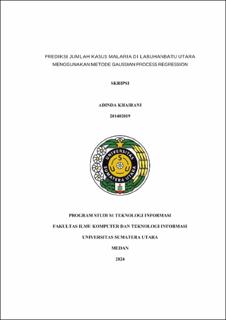| dc.description.abstract | Malaria is a life
threatening disease that can be found in tropical countries. Malaria is
caused by the bite of an infected female Anopheles mosquito. Malaria is widely found
in tropical countries, including Indonesia. In North Sumatra, some areas such as
Asahan, Batubara, and Labuhanbatu Utara still have moderate endemic status for
malaria. This study aims to predict the number of malaria cases in Labuhanbatu Utara
using the Gaussian Process Regression (GPR) method as a countermeasure to the
development of the number of malaria cases. The results of this study are expected to
be able to predict the number of malaria cases to mitigate the development of malaria,
estimate earlier the period at risk of experiencing a spike in cases, and become a
reference for further research in predicting events using the GPR method. The data
used includes weekly time, maximum temperature, sunshine duration, rainfall index,
rainfall index, flood and inundation index, population density and growth index, and
total malaria cases . In order to obtain a larger amount of data to improve model
performance, this study used the Time Series Generative Adversarial Network (TGAN)
method. This study shows that the GPR method with a combination of Matern and Dot
Product kernels gets fairly accurate prediction results on malaria case data. It was
found that models trained and tested using synthesized data were able to provide
relatively accurate predictions and close to actual values on a smaller scale. This is
shown by t he MSE evaluation metric value of 6.52, RMSE of 2.55 and MAE of 1.71.
While the data trained and tested with the original data gives an evaluation metric value
of MSE of 8.65, RMSE of 2.94 and MAE of 2.28. This shows that GPR is more suitable
for use with a larger amount of data so that it can improve prediction accuracy. | en_US |


